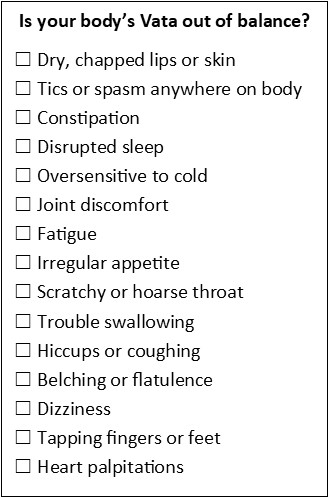


When the leaves change colors, fall from their branches, and drift away across the landscape, we are witnessing Vata in nature – the energy of movement. When the summer flowers finish their lifespan, become dry and rough, and return to the earth as primary elements we can understand the Vata characteristic of aging, cycling, and satisfying the grasp of time over matter. And when a deer leaps, a bird flits about, or a squirrel moves in and out of his
By watching nature unfold in this season, we can come to understand how Vata and its companion energies animate us. Nature has so much to teach us about our own constitution (doshas), and what happens when it falls out of balance. For example, in June of this year, a farmer in South Dakota lost his tractor to a tornado, and found it again in Montana! And in July the very Vata Berylhurricane moved nine inches of water from the ocean to the capital of Puerto Rico, displacing thousands. Vata energy facilitates the mobility of destruction, birth,

If Charaka, the father of Ayurveda (Indian Medicine), was correct that man is a microcosm of nature (recorded in 300 BCE) then what we need to know about balancing our bodies and retaining wellness is all around us, even in weather calamities. The five basic elements have conspired to create our bodies, and are managed by the doshas, the three energies which animate all matter on this planet. Wellness begins with balancing these energies.
Our seasons present such an opportunity, each having distinct characteristics. Spring is kapha with its cool rain; summer is pitta – hot, and Fall/winter is vata with its dry and cold climates. The characteristics of each season inspires unique responses from our bodies, supporting or compromising the balance of our doshas. We are constantly within this struggle – to live here with health and happiness though the environment persistently threatens to send our doshas off-kilter. To avoid illness or the expression of unwanted symptoms, we can make some small adjustments to our lifestyle to keep the doshas in equilibrium.
The Vata Fall & Winter

Fall and winter change the Earth. Long days of cold, dry climate forces wildlife and vegetation into hibernation, the promising dormancy that precedes everything wonderful and new. September, October, and November are the most challenging months for your
But getting back in the box doesn’t require your
Balancing Vata in the body
To see vata in balance in nature, watch a cloud moving slowly across the sky, or listen to leaf song as the breeze moves softly through the trees releasing our precious oxygen. Sit beside a moving creek and see the small fish continuously in motion, touching each other gently as they glide through the soft waves. Harmony is all about us offering a multitude of
When vata is in balance in you, your body systems move normally and comfortably. You don’t sleep much, maybe 6 hours a night, rising early in the morning. And sometimes, you read three books all at once!

People with a
If you feel your body’s
Diet
- Increase intake of naturally sweet, sour and salty foods
- Eat warm, cooked foods
- Add warming herbs & spices to all your meals: ginger, cumin, cinnamon
- Drink warm fluids
- Increase intake of high quality oils and butter
- Eat slowly, resting while sitting up afterwards
- Eat in peaceful, beautiful, warm environment
- Eat at regular times. Vata’s benefit from 4 small meals daily: 7 a.m., noon, 4:00 tea, 6:00
Yoga
Adopt a few grounding asanas to your daily practice:

- Makarasana (crocodile)
- Paschimotanasna (seated forward fold)
- Padmasana (lotus pose)
Lifestyle
- Stay warm
- Massage yourself daily with warm sesame oil
- Wear natural, soft fabrics
- Take gentle exercise like walking, yoga, or Tai Chi
- Keep a consistent schedule
- Bed by 10 PM. Get around 6 hours sleep. Rise immediately in the morning upon waking.
- Plan your most important work between 2:00-6:00 when your energy is highest
Balancing the Vata Mind

When
Happily, righting this misdirected enthusiasm might be as easy as providing direction for its innate vitality. I know that for
- Add organic scents to your infuser, or essential oil for the body : lavender, clary sage, basil, orange, rose, geranium, clove, patchouli, vanilla
- Use more warming colors in decorating and summer clothing: yellow, orange, green, purple
- Find sounds that gives the overactive vata energy of the mind something to focus on and follow, such as mellow, deep, soft music with strings, chimes, or the didgeridoo from Australia
- Hang withKapha friends – very grounded and realistic
- Don’t listen to your Pitta friends who tell you to follow the rules and march in step with them, at their speed. This is not possible and not advisable.
- Find a meditation technique that suits you best. Find a qualified teacher to teach you a few options.
As a devoted student of Ayurveda, balancing the doshas is the supreme focus of my own lifestyle and education I provide clients. As a Vata predominant person, I can now recognize the wisdom that my overactive imagination offers when it hijacks me at inopportune moments. With these few changes, we can all remain in balance this winter and dramatically increase our enjoyment of the season.
The information in this article is not intended nor implied to be a substitute for professional medical advice, diagnosis, or treatment.
References
Textbook of Ayurveda Fundamental Principles, by Vasant Lad, 2002
Ayurveda: A Life of Balance, by Maya Tiwari, 1994

